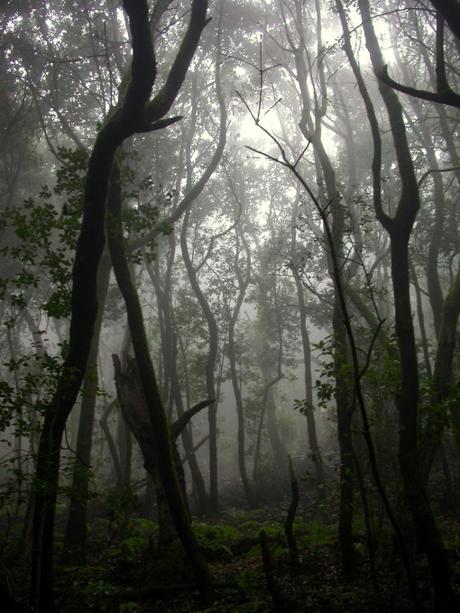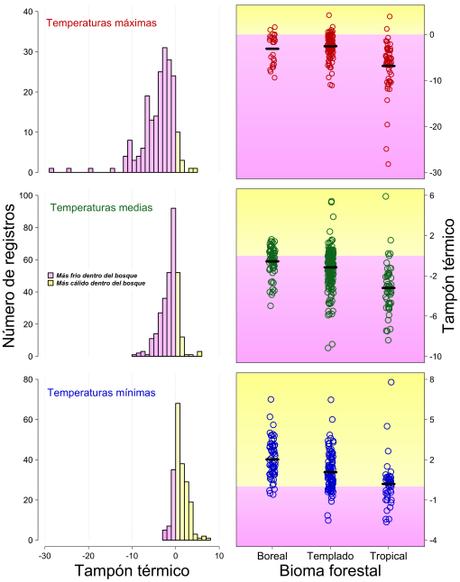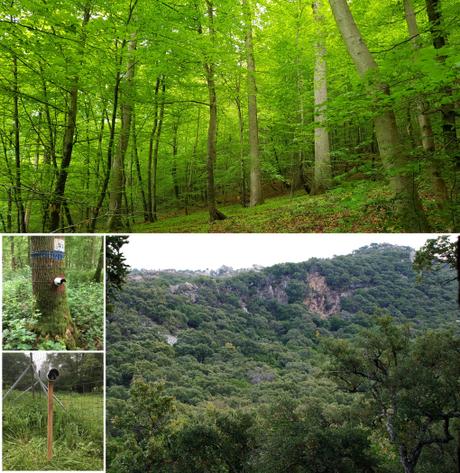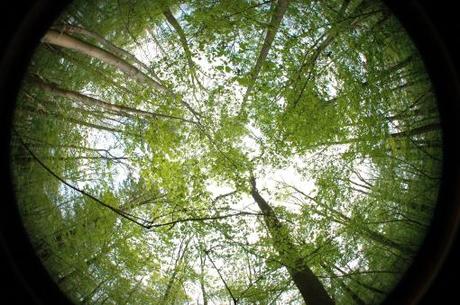Our history and culture are intimately tied to the planet’s forests and the services they provide to all living beings. In modern times, forests also help combat the impacts of anthropogenic climate change, not only by acting as powerful sinks of the carbon excess resulting from our greenhouse-gas emissions, but also as thermal shields we and many other species can benefit from.

Understory of the laurel forest in Garajonay National Park (La Gomera, Canary Islands) – also part of the World Network of Biosphere Reserves since 2012. The fog, combined with the cloud belt blowing from the Atlantic Ocean against the mountains (Garajonay is the highest peak at 1500 m), creates a mesic microclimate crucial for plant endemism. Forest canopies reinforce humidity and buffer temperature variation for many species. Photo: Paco Rodríguez.
If we were to choose a house to live, most would likely opt for one with water and electricity supply, noiseless nights, nearby leisure and shopping, and easy communication by public transport. Lacking only one of those aspects could be off-putting.
In truth, those who have the privilege of living in a stable household value it by the full set of available commodities. Similarly, the value of an ecosystem rests on its entire repertoire of ecological functions (1). And this is particularly so for forest ecosystems.
The ecological value of a forest relies on the collection of its native characteristics (2): how many autochthonous and mature trees it can host, how much photosynthesis it fuels, how many pollinisers it feeds, how much soil and water it creates and retains, and many more (3).
With regard to climate change, forests are known by their capacity to absorb atmospheric carbon as part of their business-as-usual photosynthetic machinery in the carbon cycle (4), although their role as thermal insulators is equally important. We know this from experience: for example, the fresh breeze we enjoy when strolling under a dense canopy even on a hot day. More practically, it should come as no surprise that where trees are planted in the garden of a house determines the cost of the electricity bill, given how long and when during the day tree shade covers the house in winter and summer (5).
Pieter De Frenne has led an international collaboration that illustrates the former function in the wild by collating forest temperature records from 74 scientific papers (of a total of 706 revised) (6) — see Nature’s blogpost featuring this paper. Specifically, they gathered 714 paired records of maximum, mean and minimum temperature under the canopies versus in nearby open areas for 98 boreal, temperate and tropical forests. The study revealed that maximum and mean temperatures were 2 to 4 ºC lower inside than outside forests, respectively, as it has been shown in mature temperate forests (7). In contrast, minimum temperatures stayed 1 ºC higher inside than outside.

Forest insulation function (thermal buffer) characterised from 714 records of maximum, mean and minimum temperatures taken in 98 sites through 31 countries in three biomes and five continents (6). The inclusion of three biomes guarantees a latitudinal gradient of increasing maximum temperatures towards the tropics, and decreasing minimum temperatures towards the boreal region. The thermal buffer is the difference of understory temperatures minus temperatures in neighbouring treeless areas. Thus, negative (purple) and positive (yellow) values indicate colder or warmer temperatures inside the forest, respectively (black, bold line = mean). The forest understory tends to remain warmer when outside temperatures are high (maximum), and this is more frequent in the tropics. Alternatively, the forest understory tends to stay warmer when outside temperatures are low (minimum), and this mainly occurs in boreal forests. Mean temperatures tend to be lower in the understory.
Forests essentially dissipate more heat when regional air temperatures are high, and less when temperatures plummet. But equally important was the observation that forested areas have their own thermostat linked to the latitude of the planet. Indeed. De Frenne and collaborators also found that in the hot tropics, forests keep their understory cool more than than in temperate and boreal regions while, in the frosty boreal zone, understory temperatures exceed regional air temperatures more than in temperate and tropical zones. These authors conclude that forests buffer the thermal variability of the local and regional climate.
The saying that whoever leans close to a good tree is blanketed by good shade reinforces the scientific evidence here. We have described in a different blog that arboreal microclimates (fallen trees, bark holes, epiphytes, leaf litter) act as thermal shields for small fauna. (8). De Frenne’s findings support that such a function also takes place at the ecosystem scale, potentially protecting both large and small body-size plants and animals using forests during part or all of their life cycle (9).

Temperate forests assessed for their insulating capacity (6). The upper photo shows the understory of oaks and beeches in the Forest of Compiègne (Picardy, France), and the aerial view captures the canopy of cork oaks (Quercus suber) and Algerian oaks (Q. canariensis) in Los Alcornocales National Park (Cádiz, Spain). In the lower-left, thermal sensors permanently record ambient temperatures inside (upper panel) and outside (lower panel) the Forest of Mormal (Locquignol, France). Photos courtesy of Jonathan Lenoir (Compiègne), Matthieu Déramé (Mormal), and Paco Rodríguez (Alcornocales).
The implications are massive because forests are home to 80% of terrestrial biodiversity. It’s no surprise that extinction rates rocket for forest-dwelling species in response to forest degradation (10), but we might not necessarily appreciate that this phenomenon arises not just because of the physical loss of habitat, but also because flora and fauna can be exposed to extreme temperatures if lacking the shelter of tree canopies.
In nature, 1 impact + 1 impact ≠ 2 impacts.
Simultaneous impacts on biodiversity will often multiply each other in a synergy (11), such that 1 + 1 > 2. There are plenty of examples showing this arithmetic paradox for perturbed forests and climate change.
Birds are more threatened by forest loss in periods of warming or aridification (12). When logging is concentrated in hot regions, the invasion of high altitudes by low-altitude species accelerates (13). Trees are weakened by drought and subsequently become more vulnerable to insect pests (14). Overall, forests buffer atmospheric warming but their other ecological functions (and their productivity in the form of fruits, wood, et cetera) still depend on climate (15, 16). So, if the climate changes, forests might see their functionality weaken.

Fish-eye view of the canopy of trees in the middle of their spring blossom in Gontrode (Melle, Belgium), including common oak (Quercus robur), common beech (Fagus sylvatica), sycamore maple (Acer pseudoplatanus) and common hazel (Corylus avellana), all clumped together in the forest’s overall insulating function. Photo: Pieter De Frenne.
We have also previously written about how extremely hot temperatures are driving the collapse of many forests worldwide, and we are not helping at all. Only during the period from 2000 to 2012, we have globally destroyed 4.5 times the surface of Spain and replanted 1.5 times that surface (17), so net forest loss has tripled in little more than a decade — see National Geographic’s video on deforestation, and the FAO 2018 report on ‘The State of the World’s Forests’.
If we want trees to remain playing their essential role of attenuating the impacts of anthropogenic climate change, let’s keep the top category of protection for native forests (2). And just as important, let’s not be blasé about how many forests have survived to date or are currently protected; we should instead aspire to restore deforested landscapes as well. It’s a win-win deal.
This blog post is based on an article published in Spanish by the journal Quercus in August 2019.
—
Salvador Herrando-Pérez and David R. Vieites
—
References
- Tilman, D et al. 2014. Biodiversity and ecosystem functioning. Annual Review of Ecology, Evolution, and Systematics 45: 471-493
- Watson, JEM et al. 2018. The exceptional value of intact forest ecosystems. Nature Ecology and Evolution 2: 599-610
- Felipe-Lucia, MR et al. 2018. Multiple forest attributes underpin the supply of multiple ecosystem services. Nature Communications 9: 4839
- Whitehead, D. 2011. Forests as carbon sinks—benefits and consequences. Tree Physiology 31: 893-902
- Donovan, GH and Butry, DT. 2009. The value of shade: Estimating the effect of urban trees on summertime electricity use. Energy and Buildings 41: 662-668
- De Frenne, P et al. 2019. Global buffering of temperatures under forest canopies. Nature Ecology and Evolution 3: 744-749
- Frey, SJK et al. 2016. Spatial models reveal the microclimatic buffering capacity of old-growth forests. Science Advances 2: e1501392
- Herrando-Pérez, S and Vieites, DR. 2017. El microclima va a su aire. Quercus 379: 54-56
- Bramer, I et al. 2018. Advances in monitoring and modelling climate at ecologically relevant scales, in Advances in Ecological Research, D. A. Bohan et al, Editors. Academic Press, vol. 58, chap. 3, pp. 101-161
- Betts, MG et al. 2017. Global forest loss disproportionately erodes biodiversity in intact landscapes. Nature 547: 441-444
- Brook, BW et al. 2008. Synergies among extinction drivers under global change. Trends in Ecology and Evolution 23: 453-460
- Northrup, JM et al. 2019. Synergistic effects of climate and land-use change influence broad-scale avian population declines. Global Change Biology 25: 1561-1575
- Guo, F et al. 2018. Land-use change interacts with climate to determine elevational species redistribution. Nature Communications 9: 1315
- Wong, CM and Daniels, LD. 2017. Novel forest decline triggered by multiple interactions among climate, an introduced pathogen and bark beetles. Global Change Biology 23: 1926-1941
- Wieczynski, DJ et al. 2019. Climate shapes and shifts functional biodiversity in forests worldwide. Proceedings of the National Academy of Sciences of the USA 116: 587-592
- Fei, S et al. 2018. Impacts of climate on the biodiversity-productivity relationship in natural forests. Nature Communications 9: 5436
- Hansen, MC et al. 2013. High-resolution global maps of 21st-Century forest cover change. Science 342: 850-853

